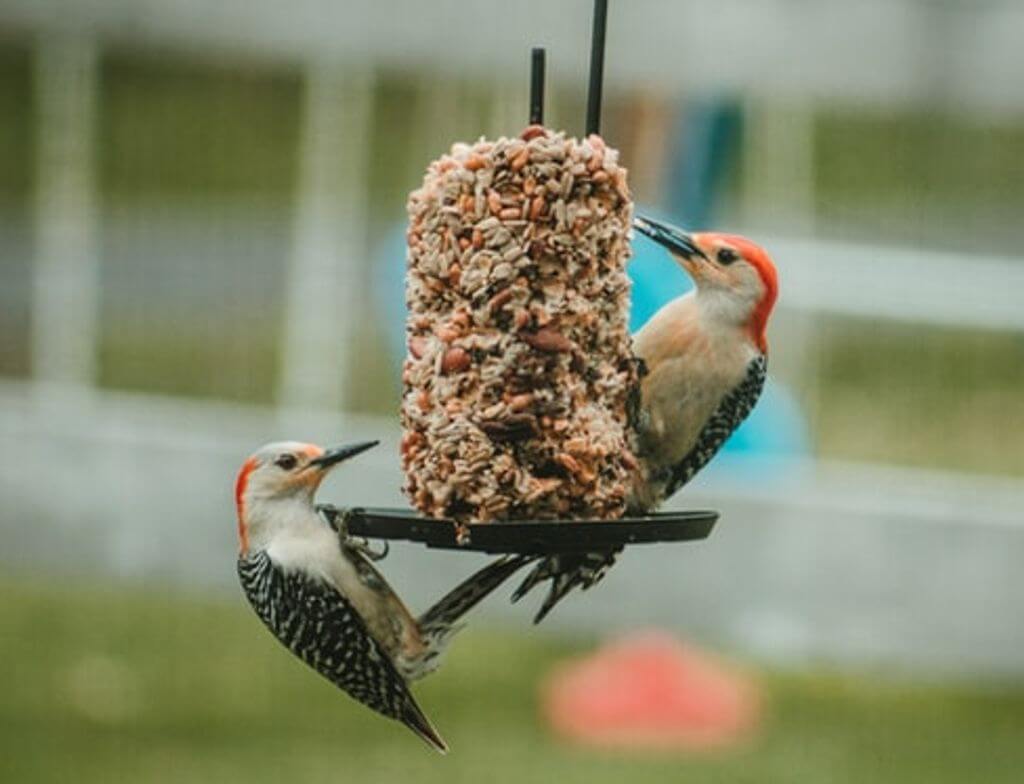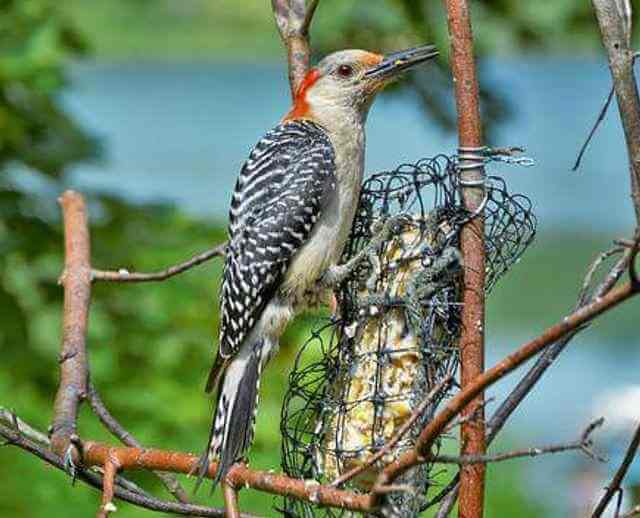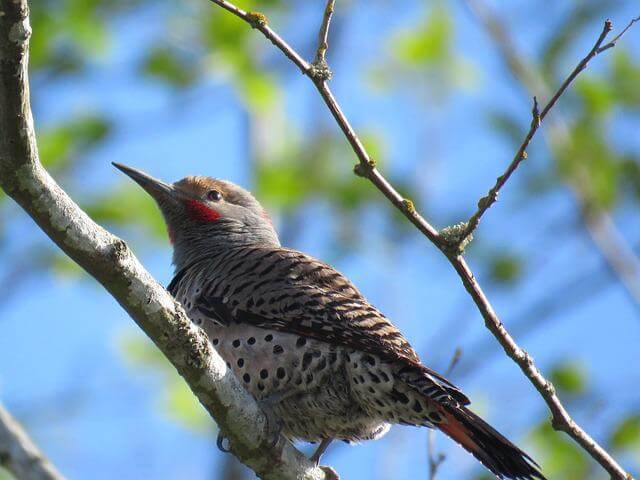Welcome to our comprehensive guide on the 10 types of woodpeckers found in Wisconsin! Woodpeckers are captivating birds known for their drumming and pecking behaviors.
In this ultimate guide, we’ll dive into the various species of woodpeckers native to Wisconsin, exploring their unique characteristics, habitats, and behaviors.
Whether you’re a birdwatcher, nature enthusiast, or simply intrigued by Wisconsin’s wildlife, this guide is your ultimate resource for learning about these remarkable birds.
Table of Contents
Types of Woodpeckers in Wisconsin
Downy Woodpecker
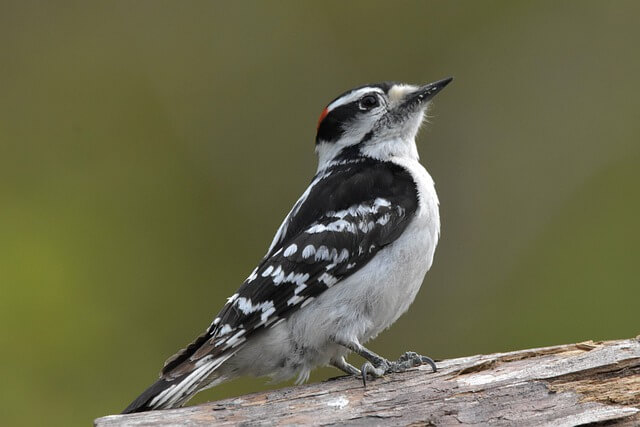
- Length: 5.5-6.7 in (14-17 cm)
- Weight: 0.7-1.0 oz. (21-28 g)
- Wingspan: 9.8-11.8 in (25-30 cm)
- Scientific Name: Picoides pubescens
- Frequency of Occurrence: 34.20% (Statistic by: eBird)
- Where To Find Them: Downy Woodpeckers are seen throughout Wisconsin, but their numbers seem to be highest in the eastern and southern parts of the state.
- How to Attract: Downy Woodpeckers like to eat insects, so providing a bird feeder that is filled with insects will attract them. You can also place suet cakes near a tree or post, or put out a dish of water for them to drink from. Making your yard hospitable for Downy Woodpeckers means providing them with trees or other structures to cling to, as well as dead wood on which they can peck. You can also plant shrubs and flowers that provide berries and seeds.
Description: Downy woodpeckers are small North American birds that live in forests and woodlands. Downy woodpeckers have a range of about 8,000 square miles and can be found in most of the continental United States and southern Canada. Downy woodpeckers prefer deciduous trees for nesting and dieting, but they will also feed on conifers.
Downy woodpeckers primarily eat insects, but they will also consume fruits and nuts. These birds nest in tree cavities, often using abandoned holes created by other animals. Downy woodpeckers are monogamous, and both parents help care for the young.
Related Post: How to Attract Downy Woodpeckers to Your Yard? (Easy!)
Red-bellied Woodpecker
- Length: 9.5 in (24 cm)
- Weight: 2.0-3.2 oz. (56-90 g)
- Wingspan: 13.0-16.5 in (33-42 cm)
- Scientific Name: Melanerpes carolinus
- Frequency of Occurrence: 27.07%
- Where To Find Them: Some of the best locations to see red-bellied woodpeckers in Wisconsin are the Apostle Islands, the Chequamegon-Nicolet National Forest, and the Milwaukee County Zoo.
- How to Attract: You can attract these birds to your yard by putting up a feeder with suet or peanut butter, and also leaving some dead trees or branches for them to perch on.
Description: The red-bellied woodpecker is a medium-size woodpecker that lives mostly in eastern North America. This species ranges from southeastern Manitoba, Canada, south to Florida and west to Texas. It is absent from the highlands of Mexico and Central America.
The red-bellied woodpecker inhabits a variety of habitats, including deciduous and mixed forests, parks, suburban areas, and orchards. It forages on trees for insects and other invertebrates. This woodpecker excavates a cavity in a tree to nest in. A typical egg clutch consists of four or five eggs.
Related Post: How to Attract Red-bellied Woodpeckers to your Yard?
Hairy Woodpecker
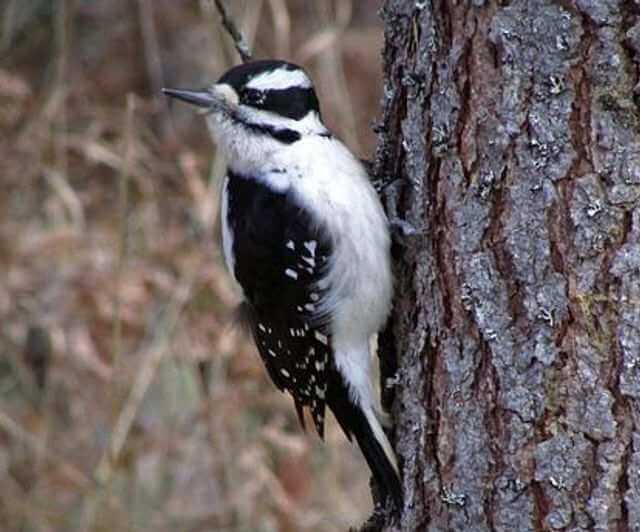
- Length: 7.1-10.2 in (18-26 cm)
- Weight: 1.4-3.4 oz. (40-95 g)
- Wingspan: 13.0-16.1 in (33-41 cm)
- Scientific Name: Picoides villosus
- Frequency of Occurrence: 19.51%
- Where To Find Them: Some of the best locations in Wisconsin to see them include the Horicon Marsh National Wildlife Refuge, the Kettle Moraine State Forest, and the Apostle Islands National Lakeshore.
- How To Attract: First, try planting a variety of trees and shrubs that provide food for woodpeckers. This includes trees such as oak, maple, and birch, as well as shrubs like elderberry and viburnum. You can also provide a source of water for the birds by installing a birdbath or fountain.
Description: The Hairy Woodpecker is a medium-sized woodpecker that ranges throughout much of North America. They typically live in deciduous forests, but can also be found in pine barrens, riparian zones, and suburban areas. These birds feed on a variety of insects, including ants, beetles, caterpillars, and grubs.
They also consume fruit and nuts. Hairy Woodpeckers construct their nests by drilling into dead trees or stumps. The male and female work together to create the nest cavity, which is typically around 6 inches wide and 12 inches deep. The female lays 3-5 eggs, which are incubated by both parents for about two weeks.
Northern Flicker
- Length: 11.0-12.0 in (28-31 cm)
- Weight: 3.9-5.6 oz. (110-160 g)
- Wingspan: 16.5-20.0 in (42-51 cm)
- Scientific Name: Colaptes auratus
- Frequency of Occurrence: 14.73%
- Where To Find Them: Wisconsin is a great place to see Northern Flickers. Some of the best locations include the Horicon National Wildlife Refuge, the Ice Age National Scenic Trail, and Devil’s Lake State Park. Northern Flickers can be seen in all seasons, but they are most commonly seen in the fall and winter.
- How To Attract: One way to attract these birds is by providing them with a source of water. A small birdbath or even a shallow dish of water will do. You can also plant trees and shrubs that provide shelter and food, such as mulberry, sumac, and elderberry. Finally, make sure to keep your yard clean and free of debris, as the Northern Flicker is known for scavenging for food.
Description: The Northern Flicker is a medium-sized woodpecker that ranges throughout most of North America. They inhabit open woodlands, parks, and gardens. These birds are usually seen foraging on the ground or high up in trees for insects. They also eat fruits and seeds.
Northern Flickers build their nests in cavities in trees, sometimes using abandoned woodpecker holes. A typical clutch contains 4-7 eggs which are incubated by both parents for about 12 days. The young fledge after another 16 days.
Related Post: How to Attract Northern Flickers to your Backyard (Easy)
Pileated Woodpecker
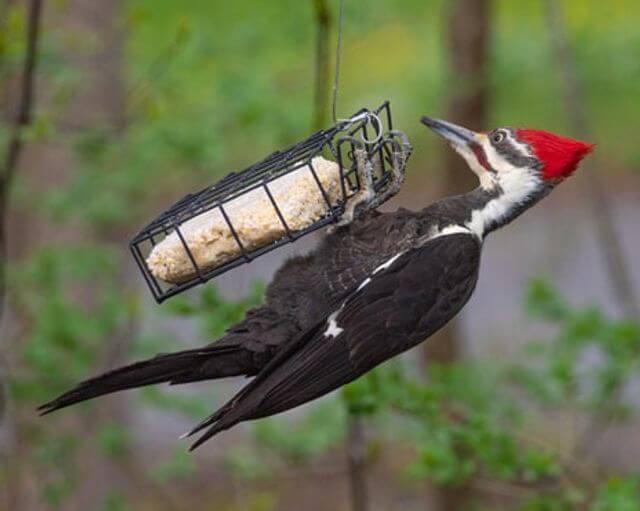
- Length: 15.8-19.3 in (40-49 cm)
- Weight: 8.8-12.3 oz. (250-350 g)
- Wingspan: 26.0-29.5 in (66-75 cm)
- Scientific Name: Dryocopus pileatus
- Frequency of Occurrence: 6.50%
- Where To Find Them: The Chequamegon-Nicolet National Forest is a great place to see pileated woodpeckers, as they are commonly found in the mixed hardwood and conifer forests there. Another great location for spotting pileated woodpeckers is the Ice Age National Scenic Trail.
- How To Attract: They love to eat insects, so adding a feeder that offers insects or suet will bring them in. You can also plant trees and shrubs that attract insects, such as maples, birches, and sumac. Another thing you can do is create some nesting sites for the birds.
Description: The Pileated Woodpecker is the second largest woodpecker in North America, and can be found throughout much of the eastern United States and Canada. They inhabit a wide variety of habitats, from dense forests to open parks and agricultural land.
These birds are omnivorous, feeding on insects, nuts, fruits, and tree sap. They nest in holes in trees, often excavating their own nesting cavity. Females lay 4-6 eggs, which are incubated by both parents for about two weeks. Chicks typically stay with parents for months after hatching.
Related Post: How to Attract Pileated Woodpeckers to your Yard (Fast)
Yellow-bellied Sapsucker

- Length: 7.1-8.7 in (18-22 cm)
- Weight: 1.5-1.9 oz. (43-55 g)
- Wingspan: 13.4-15.8 in (34-40 cm)
- Scientific Name: Sphyrapicus varius
- Frequency of Occurrence: 4.85%
- Where To Find Them: Some locations where they have been spotted include the Milwaukee County Parks system, the Horicon Marsh Wildlife Area, and Devil’s Lake State Park.
- How to Attract: Yellow-bellied sapsuckers love to feed on sap from trees, so the more trees you have, the better. In addition, try to provide a variety of tree species – both deciduous and evergreen trees will work.
Another thing that will attract these birds is a water source. A birdbath or small pond can provide the necessary hydration for these birds. Be sure to keep the water clean and free of algae buildup, as this can be harmful to the birds.
Description: The yellow-bellied sapsucker (Sphyrapicus varius) is a passerine bird that breeds in the forests of North America. The sapsucker gets its name from its habit of drilling small holes in tree trunks and feeding on the sap that flows from these holes.
This species is also known to eat insects, fruit, and nectar. The breeding habits of the yellow-bellied sapsucker are well studied, and the bird is known to build a nest made of sticks high up in a tree. The eggs of this species are incubated by both sexes, and the young are cared for by both parents.
Related Post: 16 Interesting Sapsucker Facts Revealed!
Red-headed Woodpecker
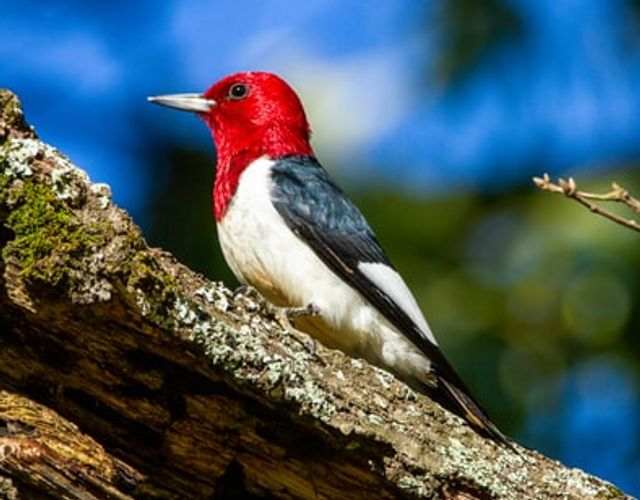
- Length: 7.5-9.1 in (19-23 cm)
- Weight: 2.0-3.2 oz. (56-91 g)
- Wingspan: 16.5 in (42 cm)
- Scientific Name: Melanerpes erythrocephalus
- Frequency of Occurrence: 2.19%
- Where To Find Them: Kettle Moraine State Forest – The forest is home to a large population of red-headed woodpeckers, making it a great place to see them. The birds can be found in the hardwood and coniferous forests throughout the park. Horicon Marsh National Wildlife Refuge – This is another great place to see red-headed woodpeckers, as they can be found in large numbers here. The marsh is also home to other interesting species of wildlife, making it a great spot for bird watching.
- How to Attract: First, make sure you have a plentiful supply of food for them. This could include suet, peanuts, or berries. You can also provide them with a birdbath. Finally, create some areas where they can find shelter, such as a tree stump or an old log.
Description: The Red-headed Woodpecker (Melanerpes erythrocephalus) is a medium-sized woodpecker found in North America. It ranges from southern Canada to northern Mexico, and is also found in parts of the Caribbean. The Red-headed Woodpecker inhabits a wide variety of habitats, including open woodlands, parks, gardens, and even orchards.
They are omnivorous, eating a variety of insects (including ants, beetles, and caterpillars), fruit, seeds, and nuts. They nest in tree cavities, either natural or excavated by the birds themselves. Up to six eggs may be laid.
Related Post: Interesting Red-Headed Woodpecker Facts (Explained)
Black-backed Woodpecker
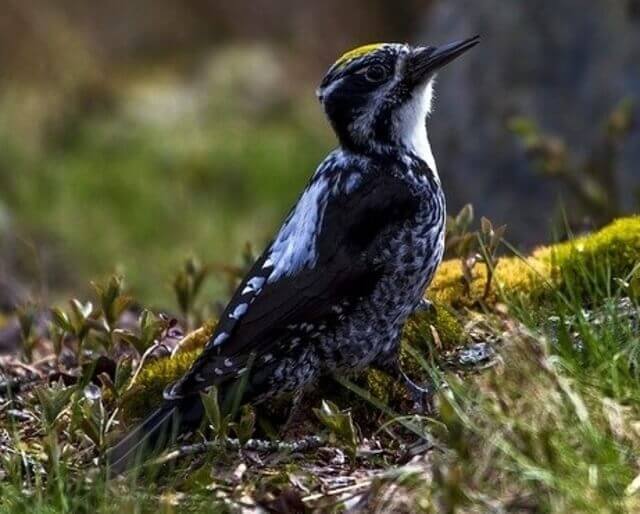
- Length: 9.1 in (23 cm)
- Weight: 2.1-3.1 oz. (61-88 g)
- Wingspan: 15.8-16.5 in (40-42 cm)
- Scientific Name: Picoides arcticus
- Frequency of Occurrence: 0.0160%
- Where To Find Them: One such spot is at the Horicon Marsh National Wildlife Refuge. This large wetland area is home to plenty of woodpeckers, and the black-backed woodpecker is among the most common. Visitors can expect to see these birds year-round, but they are particularly active during the winter months. Another great place to see black-backed woodpeckers is at Devils Lake State Park in Baraboo. This park features rolling hills and many different types of forested areas, making it an ideal habitat for woodpeckers. The black-backed woodpecker can be found here throughout most of the year.
- How to Attract: First, make sure you have a lot of dead branches in your yard. These birds love to peck at dead wood, so having plenty of it will make your yard more attractive to them. You can also put out some bird feeders filled with suet or peanut butter. This will give the birds something else to eat besides the insects they find in the trees. Finally, make sure your yard is well-maintained and free of pesticides and other chemicals.
Description: The black-backed woodpecker is a medium-sized woodpecker found in North America. The bird ranges from Alaska east to Newfoundland and south to California, New Mexico, and Texas. In winter, black-backed woodpeckers may be found as far south as Florida and Central America. The black-backed woodpecker inhabits coniferous and mixed forests.
In the summer, it can be found in open areas near trees, where it forages for insects on the ground. In winter, the bird moves to more dense forests and is less likely to be seen near the ground. Black-backed woodpeckers eat a variety of insects, including ants, beetles, termites, and carpenter ants.
Lewis’s Woodpecker

- Length: 10.2-11.0 in (26-28 cm
- Weight: 3.1-4.9 oz. (88-138 g)
- Wingspan: 19.3-20.5 in (49-52 cm)
- Scientific Name: Melanerpes lewis
- Frequency of Occurrence: 0.0108%
- Where To Find Them: Wisconsin is a great place to see Lewis’s Woodpecker. They can be found in many locations throughout the state. Some of the best locations include the Wisconsin Dells, Devil’s Lake State Park, and Apostle Islands National Lakeshore.
- How to Attract: Provide them with a large dead tree or branch that they can peck at. You can also install a bird feeder that will offer them both suet and seeds. Finally, make sure you have a source of water nearby so they can drink and bathe.
Description: Lewis’s Woodpecker (Melanerpes lewis) is a North American woodpecker that ranges from southern British Columbia to central California, and east to the western edge of the Great Plains. Lewis’s Woodpecker inhabits open woodlands, orchards, and riparian corridors.
They are usually seen foraging on tree trunks and branches for insects, but they will also eat fruit. Lewis’s Woodpeckers nest in cavities in trees, either natural or excavated by the birds themselves.
American Three-toed Woodpecker

- Length: 8.3-9.1 in (21-23 cm)
- Weight: 1.6-2.4 oz. (44.8-67.9 g)
- Wingspan: 14.6-15.3 in (37-39 cm)
- Scientific Name: Picoides dorsalis
- Frequency of Occurrence: 0.0007%
- Where To Find Them: Some of the best places include Horicon Marsh, Apostle Islands, and Nicolet National Forest. These locations offer great opportunities to see these woodpeckers in their natural habitat.
- How to Attract: You can attract American Three-toed Woodpeckers to your yard by putting out a feeder filled with suet or other bird food. You can also give them a place to perch by installing a birdhouse or placing a few large logs in your yard. If you live near a forested area, these woodpeckers may visit your yard naturally.
Description: The American Three-toed Woodpecker is a medium-sized woodpecker that ranges throughout much of North America. They inhabit a variety of habitats, including coniferous forests, mixed hardwood-coniferous forests, and riparian corridors. They forage on the bark and branches of trees, looking for insects and other invertebrates.
They also eat fruit and seeds. American Three-toed Woodpeckers nest in cavities in dead trees or large snags. The female lays 3-7 eggs, and the chicks fledge about 21 days after hatching.
Related Post: Most Common Backyard Birds In Wisconsin (Explained)

